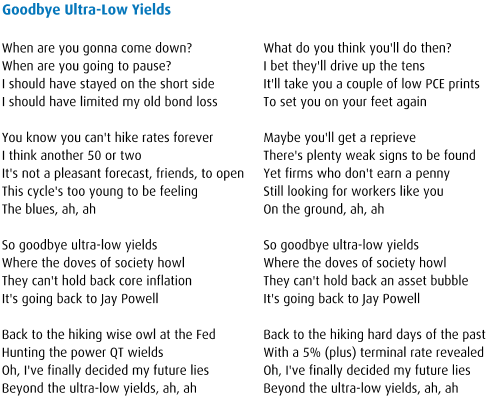Living with Higher for Longer
November 4, 2022
Douglas Porter
We are again raising our forecast assumptions for the Federal Reserve and the Bank of Canada, lifting the terminal rate for both by yet another 25 basis points. This adjustment was driven by Chair Powell’s clear-cut press conference message, a string of relatively robust economic results for October, and even the renewed strength in oil prices. In addition, we anticipate firm readings on the coming CPI releases in the U.S. (next Thursday) and Canada (Nov. 16). As a result, we now look for a further 100 bps of cumulative hikes by the Fed, taking its key rate ultimately to a 4.75%-to-5.00% range by the end of 2023Q1. For the Bank of Canada, this points to an additional 75 bps of rate hikes, taking the overnight rate to 4.5% by early next year.
This week’s FOMC meeting initially appeared to stick to the script, with the 75 bp hike exactly as long expected, and the press release hinting that the rate hikes will henceforth slow. However, Powell soon quashed any positive market vibes with a series of stern messages, perhaps best captured by: “We still have some ways to go”. Markets soon began to price in a much higher ultimate destination for Fed rate hikes (i.e., above 5%, or even higher than our revised call), taking the two-year yield up 26 bps on the week to around 4.7%. After pushing well below 4% in the lead-up to the FOMC, 10-year yields then jumped again and finished the week above 4.15%.
Even prior to Powell’s tough talk, the case for a higher terminal rate was building. First, the U.S. economy is showing surprising resiliency so far in Q4. The manufacturing ISM held above the key 50 level, auto sales had one of their best months in a year as supplies revive, job openings snapped back up to 10.7 million, and payroll employment came in strong at 261,000 last month. True, the jobs report was not full-on healthy, as the companion household survey fell heavily and the jobless rate rose two ticks to 3.7%, while wage gains eased to 4.7% y/y. Still, the bigger picture is that growth looks to be grinding forward in Q4, and we are also nudging up our GDP estimate for the quarter (from just 0.1% to 1.0%).
Loaded on top of a resilient economy is the little matter that inflation just won’t quit. We expect both headline (+0.7%) and core (+0.5%) to print uncomfortably high monthly CPI readings next week, keeping the former at 8.0% y/y, and the latter at 6.6% y/y. And, oil prices are now back as an inflation additive, with WTI rising 4% on Friday to $92/bbl. The combination of OPEC+ output cuts and signs that China is poised to begin re-opening have fired crude up to levels not seen since late August. The prospect of milder restrictions also helped propel a huge rebound in China’s equity market this week, which even temporarily spilled over into North American equities on Friday. Still, the Fed-led sell-off earlier on left the S&P 500 down roughly 4% for the full week.
The case for additional rate hikes from the Bank of Canada is a little less straightforward, especially after last week’s step back in the rate hike cadence to 50 bps. The Bank looks to be less aggressive than the Fed because: 1) wage and price pressures are a little less intense in Canada, and 2) the Canadian consumer is expected to buckle under the weight of rate hikes sooner. On the latter point, the early home sales results for October point to a further setback, including a 49% y/y plunge in activity in Toronto. But, as in the U.S., we look for another troublesome CPI report ahead, with the big rebound in gasoline prices potentially driving a monthly gain as large as 1%, taking headline inflation north of 7% again.
And if there was any lingering doubt around the need for even more BoC rate hikes, the always quirky Canadian employment report thundered into the picture. After a summer lull, jobs reportedly spiked up 108,300 last month, and hourly wages jumped to 5.6% y/y. The gains were spread across all regions, and most industries, with no obvious special factors at play. It’s dangerous to read too much into one Canadian jobs report, but at the very least it raises some serious doubts over our call of no GDP growth in Q4. Somewhat countering the perky jobs data, consumer confidence took another big step back last month, while auto sales didn’t echo the bounce seen stateside, and building permits had one of the largest declines on record in September. Suffice it to say, the Canadian economic backdrop is complicated.
Despite those misgivings, we believe the inflation and economic backdrops are consistent with the need for a slightly higher terminal rate in Canada as well, with the jobs data tipping the scales. After last week’s furious bond rally, GoC yields backed up across the curve this week, with 2s up almost 30 bps to above 4.1%, and 10s up 26 bps to 3.5%. Note that while many are breathlessly awaiting an inversion of the Fed funds/10-year yield curve, Canadian overnight rates have long since moved above 10-year GoC yields. The over-riding message today is that we are not done yet, and the era of low-low interest rates is truly behind us now.
With that, we offer the following (with a small assist from Sir Elton)… the only regret is this wasn’t published after the first set of rate hikes eight months ago.

Douglas Porter is chief economist and managing director, BMO Financial Group. His weekly Talking Points memo is published by Policy Online with permission from BMO.
